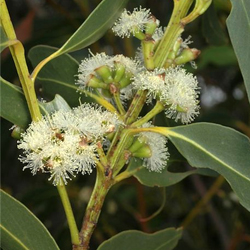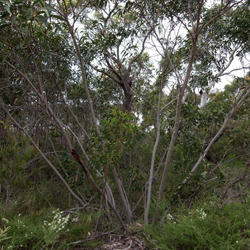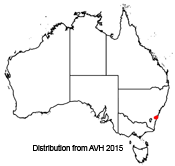Eucalyptus langleyi
 |
 |
Green Mallee Ash , Albatross Mallee
Eucalyptus langleyi L.A.S.Johnson & Blaxell
The main occurrence of Eucalyptus langleyi is to the south-west of Nowra as far as Yarramunmun Creek. A very small population is found to the north of the Shoalhaven River in the Bomaderry Creek Regional Park. It is found in heath patches surrounded by woodland.
Eucalyptus langleyi is a mallee(multi-stemmed eucalypt growing from a lignotuber) that reaches five metres in height. Juvenile leaves are glossy green and broad lanceolate to ovate. Adult leaves are glossy green 8 to 18 cm long and 1.8 to 4 cm wide with predominately thickened leaf margins. Petioles are 8 to 18 mm long and are winged, along with the stems. It produces axillary umbellasters (umbel-like flower heads) usually consisting of 7 flowers with the peduncles broadly winged up to 7 mm wide.
Propagated easily from seed, either by direct sowing or in a pot, Eucalyptus langleyi is a small ornamental tree suitable for a small garden. It requires little to no maintenance. It sheds its bark in ribbons annually revealing new pale smooth bark each year that usually has pleasing patterning on it that is different every year; as well as this the bark colour can vary year to year from brown, grey, pink to green. It flowers profusely in June making it very attractive and produces lots of viable seed. Old and damaged stems can be cut back to the base. Avoid rich soils and heavy shade and do not fertilize. E. langleyi prefers an exposed site in full sun. In the wild it grows on poor dry sandstone soils in areas of low moisture that are naturally acidic but E. langleyi is fairly tolerant of a range of pH levels. Generally in cultivation it will grow as a single stem as a result of good growing conditions or as a result of shade. If the natural mallee form is desired then the tree can be coppiced every few years. Fruits appear from July and seed is released through spring into summer. Pest and disease resistant, it may occasionally get a few scale insects.
Listed as vulnerable, it only occurs in an area estimated to be 12 x 4 km. It is not thought to be at risk from agriculture but residential development could severely impact this species. Seed is poorly distributed with seed normally within 10m of the tree and no seed sprouting has been shown after fire. It survives cool burns and can re-sprout from epicormic growth but a hot burn will cause it to die back and regrow from its lignotuber.
Daniel Fisher, Botanical Intern 2015
Name meaning: Eucalyptus langleyiEucalyptus - Greek eu, well, kalyptos, covered; refers to the cap or lid which covers the flower bud langleyi - after Lawrence Langley, who alerted the authors to the existence of the species |
References:
Department of the Environment (2015) Eucalyptus langleyi in Species Profile and Threats Database, Department of the Environment, Canberra. Available from http://www.environment.gov.au/sprat. [Accessed Feb 2015].
Hill, K.D & L.A.S. Johnson (1991) Systematic studies in the eucalypts 3. New taxa and combinations in Eucalyptus (Myrtaceae). Telopea 4(2): 223–267.
NSW Office of Environment and Heritage (2014) Albatross Mallee – profile. Available at http://www.environment.nsw.gov.au/threatenedspeciesapp/profile.aspx?id=10298 [Accessed Feb 2015].
![An Australian Government Initiative [logo]](/images/austgovt_brown_90px.gif)


